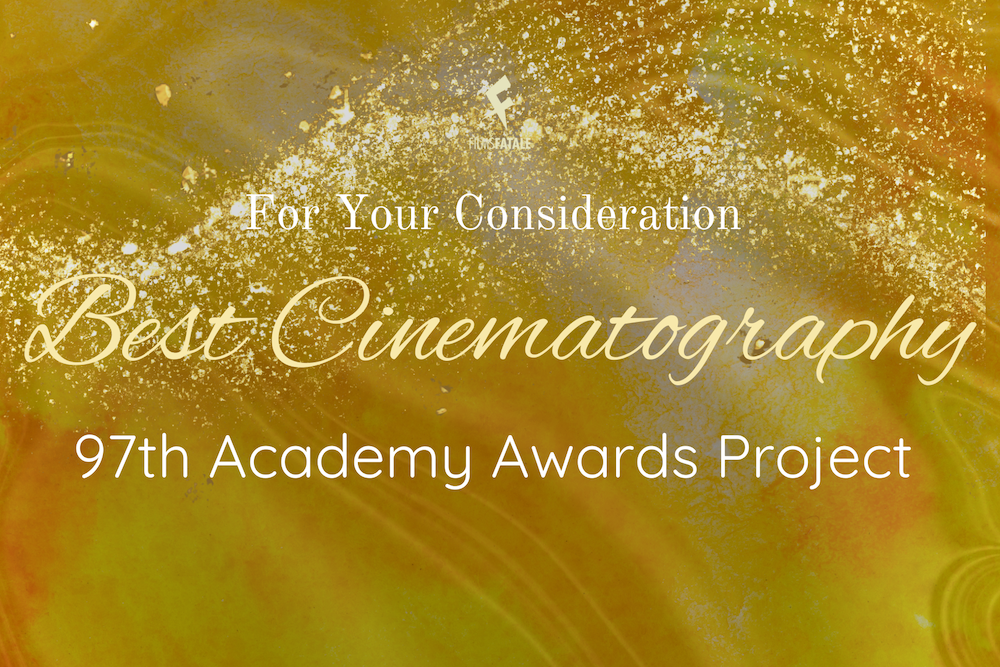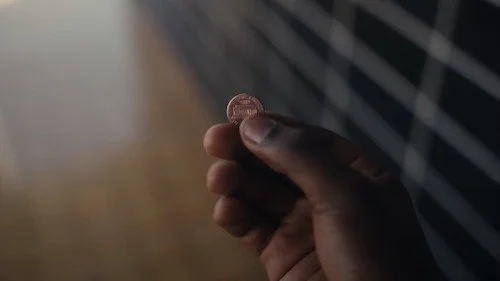Best Cinematography: Ranking Every Nominee of the 97th Academy Awards
Written by Andreas Babiolakis
We have now reached the week of the Academy Awards Project which encompasses the majority of creative and production-based nominees. We’ll kick things off with both awards that affect what we see: the organic, and the synthetic. Before we look at the Best Visual Effects nominees tomorrow, we will go through one of my favourite categories at all of these awards shows: Best Cinematography. I am a sucker for a well shot film and I do believe that great lighting, use of colours, framing, panning, zooming, and use of photographical techniques can greatly elevate any film. You’ll almost always find nothing but strong candidates in this category every year, and that is not going to change this time around. Having said that, we are also looking at a category that is somehow omitting one of the best shot films of the twenty first century (more on that shortly). Which of the films below had the best cinematic photography and why?
Here are your nominees for Best Cinematography ranked from worst to best.
Biggest Snub: Nickel Boys-Jomo Fray
How the hell did the Academy forget to nominate Jomo Fray’s work for Nickel Boys here? Possibly the worst snub of the year, I couldn’t think of a film more deserving to win this award than Nickel Boys, and yet it wasn’t even nominated. It goes without saying that the first-person perspective gimmick is perfected in this film, and the film is only enhanced by the countless ways that Fray decides to “bump the lamp” (an industry term used to describe a filmmaker going the extra mile when it didn’t need to, which refers to the scene in Who Framed Roger Rabbit when the titular character bumps a lamp accidentally and causes the shadows of the scene to shift at every second, creating a much harder job for both animators and the cinematographer; the end result is to die for). All things considered, I honestly think Nickel Boys is one of the best looking films of the twenty-first century. It has impeccable lighting, fascinating compositions, and an identity that it never wavers from (and nails for over two hours). How AMPAS got it so wrong is beyond me. I know members watched this film because it is up for Best Picture. They noticed that it’s one of the best films of the year without noticing that it is easily the best looking film of 2024? Please explain this to me. Even with the stiff competition below, Nickel Boys not being nominated here is sacrilegious.
5. Emilia Pérez-Paul Guilhaume
I think Emilia Pérez is well shot, but I’d easily place it last of these nominees. There are moments that shine with rich colours, deep shadows, and other cases of visual splendour. I think Academy voters were more interested in how the camera moves in this film, with many instances of quick-whip panning, as if the mechanism is dancing with the stars of the film. The balance between close-ups and mid ranged shots also helps solidify this illusion as well, as it feels like we’re stepping to and from our focal points quite often (think of us waltzing). Having said all of that, again, Emilia Pérez is actually a great looking film, but I still think there are other films that could have taken the fifth spot here; I’ve already detailed Nickel Boys, but there’s also Queer, The Substance, Conclave, The Girl and the Needle, and quite a few other films that I felt like had stronger cinematography this year. I don’t think you’ll ever find poorly shot films nominated for this category, since every year boasts many films with strong visual composition, but I do think you can still have glaring omissions.
4. Nosferatu-Jarin Blaschke
The jump in quality from this point on is quite a large one. Off the top of my head, I thought Nosferatu was one of the best looking films of the year, so to find myself placing it fourth amongst the overall nominees feels so wrong. Consider this a sign of how stacked this category is as opposed to the quality of Nosferatu’s cinematography. While I do love the dark, shadowy, pseudo-greyscale scenes that feel like they have had all of the blood and life sucked out of them, I wasn’t accounting for how lush the "period piece” sequences would look with their muted-yet-poignant pastel colours; you come in to Nosferatu anticipating the gothic obsidian, and you will leave being just as astounded by the humanistic beauty of the film. I cannot discuss the cinematography of this film without bringing up the magnificent use of camera pans, especially in Count Orlok’s castle, as if we are the vampiric overlord himself skulking around the shadows of his domain and stalking his prey. The overhead shots fill me up with so much dread as well (and the extreme close-ups only seal the deal), while the more tender medium-wide shots during the calmer moments bring some necessary breath back into the film. Any other year, Nosferatu may be the winner of this category. 2024 is one hell of a strong year in this category, unfortunately, but I still adore how this film looks.
3. Maria-Ed Lachman
While I am sad that Maria barely got nominated at all (justice for Angelina Jolie being snubbed, considering she delivered the best performance of her career and one of the strongest exhibitions of acting this past year), at least it was recognized for how it was shot. Ed Lachman takes a page out of the The Double Life of Veronique book with a film that is exceptionally olive, amber, and mahogany (with so many other hues in between). This creates an artifact-feeling environment, as if we are watching a golden idol rust and oxidize away (while hints of glory still shine). The use of angles, lighting, and other trickery really seal the deal here, as Maria is never a dull moment simply because of how it is shot. Considering that a major plot point of the film is how Maria Callas is hallucinating during her last week alive, the cinematography here does a fantastic job of blurring the lines between reality and the subconscious. I can’t forget the stunning black-and-white flashback sequences that feel like they came out of an Ingmar Bergman film, as if they are the means of the character study the film is conducting on the opera legend. I cannot emphasize enough how beautiful Maria is visually, and I am thrilled that it at least got acknowledged for its astonishing cinematography. Sadly, again, it is quite a tough year, so I can’t even rank this higher than third.
2. Dune: Part Two-Greig Fraser
Dune already looked fantastic, and Greig Fraser’s work on Dune: Part Two takes the ideas and splendour of the first film and goes even further with them. The sepia, orange, and golden visuals look even stronger, with massive shots and fascinating angles to really sell the sensation of us being transported to a whole new reality. The colour blue — be it the eyes of those who consume spice or the waters that bring life amidst arid landscapes — pierce through the desert colour palette, and I feel like these moments are a bit more prominent in this sequel than in the original Dune. On the topic of colour, I must highlight the black-and-white, monochromatic photography on the Harkonnen planet, captured using infrared cameras to achieve the effect; this cinematography stands out in a film that already looks astonishing. What else is there to say about how Dune: Part Two looks that isn’t obvious? It was expected that this juggernaut of a film would wind up in these kinds of tech and creative categories.
1. The Brutalist-Lol Crawley
In a year full of well-shot films, one manages to stand tall amongst the other nominees. Since Nickel Boys isn’t here, the best nominated film here is The Brutalist. For nearly four hours, Lol Crawley takes each and every single shot and gives us a jaw-dropping experience. When he isn’t experimenting with unorthodox angles and zooms, he is performing a tightrope act with focusing. The film utilizes overlays, meditative passages, insanely wide shots that feel gargantuan, extreme closeups that dial us in, and so many other daring risks that always succeed. I don’t have enough space or time to go into the use of shadows, the piercing lights, the frequent dolly shots of speeding vehicles facing the limitless horizon ahead of them, the uses of blues and greens versus warm, golden auras, and the ten thousand other ideas happening all at once here. The Brutalist is an uncompromised film composed of daring concepts and executions, and this couldn’t be more true with how it was shot, making it the strongest nominee.
Who I Want To Win: I’d love if The Brutalist, Dune: Part Two, Maria, or Nosferatu won, which sounds like a cop-out, I’m sure, but I do think that they are all brilliantly shot films that are worthy of acclaim.
Who I Think Will Win: Given its unstoppable force right now, I’m predicting The Brutalist will take home this award. The only other film I can imagine overtaking it is Dune: Part Two, especially since the first installment of this series won this very award a few years ago. Even so, I’m placing figurative money on The Brutalist.
The Academy Awards Project will continue tomorrow with another category: Best Visual Effects. We’re going to rank every single nominee in every single category, Monday through Friday. You don’t want to miss it!
Andreas Babiolakis has a Masters degree in Film and Photography Preservation and Collections Management from Ryerson University, as well as a Bachelors degree in Cinema Studies from York University. His favourite times of year are the Criterion Collection flash sales and the annual Toronto International Film Festival.









